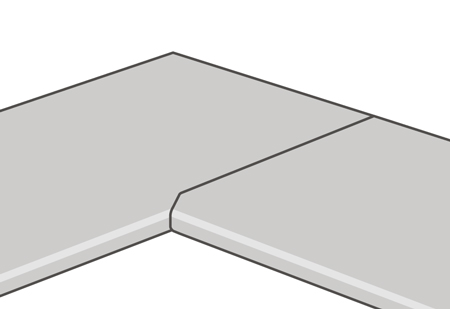Worktop Joints: A Worktop Express® Nutshell Guide
You will need to know about the different worktop joints that are available, we used different joining options for the different worktop materials.
Butt Joint
When joining two wooden worktops together at a 90˚ angle, a butt joint is the preferred method. This method allows you to join two worktops together neatly without interrupting the wood’s grain pattern, whilst ensuring that the timber can still expand and contract without bowing or splitting.

Recesses that accommodate a set of worktop connector bolts are routed into the underside of the worktop. This invisible join makes it easy to connect the two worktops; moreover, this can be done without the help of a professional fitter, as only a small amount of sealant is required to fill the gap between the two worktops.
You can read more about this method of joining two wood worktops by reading our Butt Joints Nutshell Guide.
Mason’s Mitre Joint
A mason’s mitre joint is one of the most popular type of worktop joints used to connect two laminate worktops, as it provides a neat join that minimises wastage when compared to a 45˚ mitre joint.

A mason’s mitre joint is sometimes known as a ‘hockey stick’ joint (thanks to the curve in the join at the front edge of the worktop). These worktop joints can be made easily by using one of our worktop jigs, all of which include an aperture for creating a mason’s mitre joint.
If you would prefer that your laminate worktops arrive ready to install, this joint can be created prior to delivery of your worktops via our laminate worktop cutting service.
Want to know more? Read our ‘Mason’s Mitre Joints for Kitchen Worktops’ information guide.
Biscuit Joint
When joining our slimline range of worktops, biscuit joints are the perfect way to create extra-strong join.
This style of biscuit joint has pockets machined into the edge of the worktops to be connected, which will need to be filled with standard size 20 biscuits.
This technique provides a secure join and wastes less material compared to a traditional 90° biscuit joint. Unika TopSeal or a clear 2-part epoxy resin can be used to fix the biscuits in place, securely fasten the surface together and also work as a waterproof sealant.
Creating the perfect biscuit joint is not an easy process, so we recommend taking advantage of our bespoke cutting service if you require an extra-large worktop.

Customisation Services
Ensure a stress-free installation by fully tailoring your worktops so they arrive ready to fit with our Customisation Service, saving you time and money on installation.
Available across our entire collection, our highly skilled team uses expert machinery to achieve precise cuts and since we customise more worktops pre-installation than anyone else, your dream kitchen is in safe hands.


 65,000+ Reviews | 4.8 TrustScore
65,000+ Reviews | 4.8 TrustScore